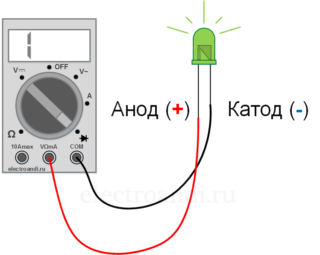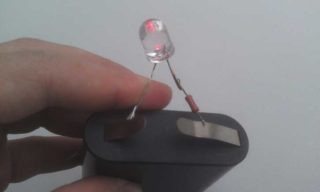For the device of spot lighting, craftsmen often use LEDs. These small bulbs are capable of delivering good performance with minimal power consumption. In addition, they last much longer than conventional incandescent lamps. But when installing the lighting circuit, it is important to consider the polarity of the LED. Otherwise, it simply will not work on the supplied current or it will quickly fail.
Details about the polarities of LED lamps

Such small points of illumination work on the principle of current flowing through them only in the forward direction. From this arises the optical radiation of the bulb. If the polarity is not observed when connecting, the current will not be able to make a direct path for itself through the circuit. Accordingly, the lighting device will not work.
Thus, before installing the LED, the master must know the location of its cathode and anode ("+" and "-"). This is not difficult to do, knowing certain principles of visual assessment of a light bulb or the operation of electrical appliances in combination with an ICE element.
Polarity detection methods

There are several main methods by which you can find out where the plus is for the LED, and where is the minus. The easiest way is to visually inspect the element and determine the polarities by appearance.
The characteristic feature of the new LED elements is the length of the legs. The anode (plus) will always be longer than the cathode (minus). As a reminder to the master - the first letter "K" from the word "cathode" means "short". You can visually evaluate the bulb of a light bulb. If it is clearly visible, the master will see the so-called "cup". There is a crystal in it. This is the cathode.
It is also worth paying attention to the bezel of the LED part. Many manufacturers prefer to affix a special marking opposite the cathode. It may look like a serif (risk), a small slice, or a dot. It's hard not to see them.
New variant of LED marking - signs "+" and "-" on the base. Thus, the manufacturer makes it easier for the master to work, helps to determine the polarity. Sometimes it is possible to mark with a green line opposite the plus.
Using a multimeter

If you cannot visually identify the LED - anode / cathode - you can use special equipment. This is a multimeter. The entire verification procedure will take less than a minute. They act in this way:
- The device is set to the resistance measurement mode.
- The probes of the multimeter are neatly connected to the legs of the LED light. The presumptive plus is put to the red wiring. Minus - to black. In this case, the touch is made short-term.
- If the contacts are installed correctly, the device will show a resistance close to 1.7 kOhm. If the connection is wrong, nothing will happen.
The multimeter can also be operated in the diode test mode. Here, if the polarities are correctly observed, the bulb will give light. This recommendation works especially well with green and red diodes. White and blue require more than 3V voltage, so even with correct connection they may not light up.
To check the elements of these colors through a multimeter, you can use the transistor characterization mode.It is found on all modern models of devices. Here they act like this:
- Set the desired mode.
- The light bulb is inserted into the special grooves C (collector) and E (emitter) with the legs. They are for the transistor at the bottom of the device.
If the minus of the LED is connected to the collector, the bulb will give light.
Voltage supply method

Voltage sources (rechargeable battery) can be used to determine the polarity of the LED. But it is best to use a laboratory power supply with continuous voltage regulation, as well as a DC voltmeter.
They act in this way:
- The LED bulb is connected to a power source and the voltage is slowly raised.
- If the polarities of the element are observed correctly, the LED will give a color.
- If, when reaching 3-4 V, the light does not light up, the plus and minus are connected incorrectly.
When the light comes on, there is no need to keep increasing the voltage. The element from such experiments will simply burn out..
If the master does not have a power supply unit or a 5-12 V battery, you can connect several 1.5 V elements in series with each other. A battery from a mobile phone or a car will come in handy here. But it is worth remembering: when connecting LED elements to powerful devices, it is recommended to use a current-limiting resistor in parallel.
Determination of polarity using technical documentation
If the LED is just purchased, it comes with technical documentation from the manufacturer. Here are some basic information about light bulbs:
- weight;
- pinout of LEDs;
- dimensions;
- electrical parameters:
- sometimes pinout (connection diagram).
When buying items at retail, you can ask the seller to get acquainted with the information so as not to suffer at home and not look for where the LEDs have a plus and a minus. A corresponding conclusion is made on the securities.
When it is required to determine the polarity of LED-lamps

Small LEDs are widely used in various fields of lighting and indication:
- street lighting: advertising signs, park lights;
- household elements of artificial light: lighting of work panels, the perimeter of the suspended ceiling, built-in furniture, etc.;
- indication of electrical appliances on / off modes: self-made smart sockets, etc.;
- Kids toys;
- remote controls and much more.
If a light bulb fails, the master resorts to replacing it. In this case, it is required to determine the anode and cathode of the LED. Otherwise, the element simply won't give out lighting.
On various forums there is information that it makes no sense to look for where the LED "hides" plus and minus. There are frequent judgments that a light bulb can be connected without observing the polarities. There are nuances here. Even if the master is lucky and the element gives light, ultimately it will lead to the following consequences:
- The service life of an incorrectly connected light bulb, declared by the manufacturer, will be reduced significantly. For example, with a guaranteed mode of 45,000 hours, the LED will work in half.
- Performance (intensity, brightness of light) will decrease significantly from what it should be. In the general circuit, this will be visible to the naked eye.
Such games with polarities and the probability of operation of a diode element directly depend on the characteristics of a particular semiconductor and breakdown voltage.
The average life of LED bulbs is 10 years. With their moisture protection IP67 or more, the elements can be safely used when arranging street lighting. In order for the LEDs to work for the stated period, it is worthwhile to fundamentally observe the polarities when connecting them and determine with them before carrying out repair work, and not after.









when determining the polarity using batteries, the current-limiting resistor is connected in series